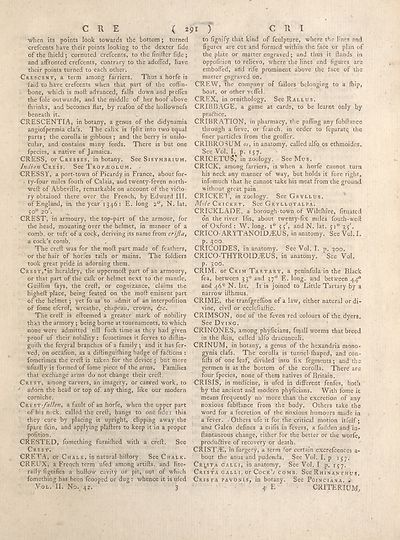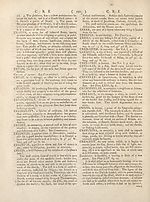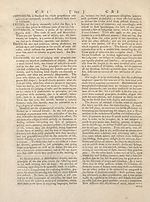Encyclopaedia Britannica; or, A dictionary of arts and sciences, compiled upon a new plan … > Volume 2, C-L
(319) Page 291
Download files
Complete book:
Individual page:
Thumbnail gallery: Grid view | List view

C R E (291
■when its points look towards the bottom; turned
crefcents have their points looking to the dexter fide
of the fhield; cornuted Crefcents, to the finifter fide;
and affronted crefcents, contrary to the adoffed, have
their points turned to <ach other.
Crescent, a term among farriers. Thus a horfe is
daid to have crefcents when that part of the coffin-
bone, which is moft advanced, falls down and prefles
the foie outwards, and the middle of her hoof above
{brinks, and becomes flat, by reafon of the hollownefs
beneath it.
CRESCENTIA, in botany, a genus of the didynamia
angiofpermia clafs. The calix is fplit into two equal
parts; the corolla is gibbous ; and the berry is unilo¬
cular, and- contains many feeds. There is but one
fpecies, a native of Jamaica.
CRESS, or Cresses, in botany. See Sisymbrium.
/«*//>» Cress. See Tropjeolum.
CRESSY, a port-town of Picardy in France, about for¬
ty-four miles fouth of Calais, and twenty-feven north-
wefbof Abbeville, remarkable on account of the victo¬
ry obtained there over the French, by Edward III.
of England, in the year 1346: E, long 20, N. lat.
50° 20'.
CREST, in armoury, the top-part of the armour, for
the head, mounting over the helmet, in manner of a
comb, or tuft of a cock, deriving its name from crijia,
a cock’s comb.
The creft was for the moft part made of feathers,
or the hair of horfes tails or mains. The foldiers
took great pride in adorning them.
Crest,*in heraldry, the uppermoft part of an armoury,
or that part of the cafk or helmet nekt to the mantle.
Guillim fays, the creft, or cognizance, claims the
higheft place, being feated on the moft eminent part
of the helmet; yet fo as to admit of an interpofition
of fome efcrol, wreathe, chapeau, crown, &c.
The creft is efteemed a greater mark of nobility
th*n the armory; being borne at tournaments, to which
none were admitted till fuch time as they had given
proof of their nobility: fometimes it ferves to diftin-
guifh the fevfral branches of a family ; and it has fer-
ved, on occafion, as a diftinguiffiing badge of fa&ions :
fometimes the creft is taken for the device ; but more
ufually is formed of fome piece of the arms. Families
that exchange arms do not change their creft.
Crest, among carvers, an imagery, or carved work, to
7 adorn the head or top of- any thing, like our modern
corniche.
Crest-/v//<?«, a fault of an horfe, when the upper part
of his neck, called the creft, hangs to one fide : this
they cure by placing it upright, clipping away the
fpare {kin, and applying plafters to keep it in a proper
pofition.
CRESTED, fomething furnifhed with a creft. See
Crest,
CRETA, or Chalk, in natural-hiftory See Chalk.
CREUX, a French term ufed among artifts, and lite¬
rally fignifies a hollow cavity or pit, out of which
fomething has been fcooped or dug: whence it is ufed
Vol. II. No. 42. 3
) C R I
to fignify that kind of fculpture, where the lines and
figures are cut and formed within the face or plan of
the plate or matter engraved; and thus it (lands in
oppofition to relievo, where the lines and figures are
emboffed, and rife prominent above the face of the
matter engraved on.
CREW, the company of failors belonging to a ffiip,
boat, or other vcffel.
CREX, in ornithology. See Rallus.
CRIBBAGE, a game at cards, to be learnt only by
prafHce. .
CRIBRATION, in pharmacy, the pafling any fubftance
through a fieve, or fcarch, in order to feparatq the
finer particles from the grofler.
CRIBROSUM os, in anatomy, called alfo os ethmoides.
See Vol. I. p. 157.
CRICETUf?,* in zoology. See Mus.
CRICK, among farriers, is when a horfe cannot turn
his neck any manner of way, but holds it fore right,
infomuch that he cannot take his meat from the ground
without great pain
CRICKET, in zoology. See Gryllus.
Mote Cricket. See Gryllotalpa.
CRICKLADE, a borough-town of Wiltfhire, fituated
on the river Ifis, about twenty-fix miles fouth-weft
of Oxford : W. long. i° 5 5/, and N. lat. 510 35'.
CRICO-ARYTANOIDiEUS, in anatomy. See Vol. I.
p. .300.
CRICOIDES, in anatomy. See Vol. I. p. 300.
CRICO-THYROIDJEUS, in anatomy. See Vol.
p. 300.
CRIM, or Grim Tartary, a peninfula in the Black
fea, between 330 and 370 E. long, and between 440
and 46’ N. lat. It is joined to Little Tartary by a
narrow ifthmus.
CRIME, the tranfgreffion of a law, either natural or di¬
vine, civil or ecclefiaftic.
CRIMSON, one of the feven red colours of the dyers.
See Dying.
CRINONES, among phyficians, fmall worms that breed
in the (kin, called alfo dracunculi.
CRINUM, in botany, a genus of the hexandria mono-
gynia clafs. The corolla is tunnel-(haped, and con-
fifts of one leaf, divided into fix fegments; and the
germen is at the bottom of the corolla. There are
four fpecies, none of them natives of Britain.
CRISIS, in medicine, is ufed in different fenfes, both
by the ancient and modern phyficians. With fome it
means frequently no' more than the excretion of any
noxious fubftance from the body. Others take the
word for a fecretion of the noxious humours made in
a fever. • Others ufe it for the critical motion itfelf;
and Galen defines a crifis in fevers, a fudden and'in-
ftantaneous change, either for the better or the worfe,
produiftive of recovery or death.
GRISTLE, in furgery, a term for certain excrefcences a-
bout the anus and pudenda. See Vol. I. p 157.
Cr^stA galli, in anatomy. See Vol. I p. 157.
Crista galLi, or CockV comb. See Rhi nan thus.
Crista pavOnis, in botany. See Poinciana. .
4 E CRITERIUM,
■when its points look towards the bottom; turned
crefcents have their points looking to the dexter fide
of the fhield; cornuted Crefcents, to the finifter fide;
and affronted crefcents, contrary to the adoffed, have
their points turned to <ach other.
Crescent, a term among farriers. Thus a horfe is
daid to have crefcents when that part of the coffin-
bone, which is moft advanced, falls down and prefles
the foie outwards, and the middle of her hoof above
{brinks, and becomes flat, by reafon of the hollownefs
beneath it.
CRESCENTIA, in botany, a genus of the didynamia
angiofpermia clafs. The calix is fplit into two equal
parts; the corolla is gibbous ; and the berry is unilo¬
cular, and- contains many feeds. There is but one
fpecies, a native of Jamaica.
CRESS, or Cresses, in botany. See Sisymbrium.
/«*//>» Cress. See Tropjeolum.
CRESSY, a port-town of Picardy in France, about for¬
ty-four miles fouth of Calais, and twenty-feven north-
wefbof Abbeville, remarkable on account of the victo¬
ry obtained there over the French, by Edward III.
of England, in the year 1346: E, long 20, N. lat.
50° 20'.
CREST, in armoury, the top-part of the armour, for
the head, mounting over the helmet, in manner of a
comb, or tuft of a cock, deriving its name from crijia,
a cock’s comb.
The creft was for the moft part made of feathers,
or the hair of horfes tails or mains. The foldiers
took great pride in adorning them.
Crest,*in heraldry, the uppermoft part of an armoury,
or that part of the cafk or helmet nekt to the mantle.
Guillim fays, the creft, or cognizance, claims the
higheft place, being feated on the moft eminent part
of the helmet; yet fo as to admit of an interpofition
of fome efcrol, wreathe, chapeau, crown, &c.
The creft is efteemed a greater mark of nobility
th*n the armory; being borne at tournaments, to which
none were admitted till fuch time as they had given
proof of their nobility: fometimes it ferves to diftin-
guifh the fevfral branches of a family ; and it has fer-
ved, on occafion, as a diftinguiffiing badge of fa&ions :
fometimes the creft is taken for the device ; but more
ufually is formed of fome piece of the arms. Families
that exchange arms do not change their creft.
Crest, among carvers, an imagery, or carved work, to
7 adorn the head or top of- any thing, like our modern
corniche.
Crest-/v//<?«, a fault of an horfe, when the upper part
of his neck, called the creft, hangs to one fide : this
they cure by placing it upright, clipping away the
fpare {kin, and applying plafters to keep it in a proper
pofition.
CRESTED, fomething furnifhed with a creft. See
Crest,
CRETA, or Chalk, in natural-hiftory See Chalk.
CREUX, a French term ufed among artifts, and lite¬
rally fignifies a hollow cavity or pit, out of which
fomething has been fcooped or dug: whence it is ufed
Vol. II. No. 42. 3
) C R I
to fignify that kind of fculpture, where the lines and
figures are cut and formed within the face or plan of
the plate or matter engraved; and thus it (lands in
oppofition to relievo, where the lines and figures are
emboffed, and rife prominent above the face of the
matter engraved on.
CREW, the company of failors belonging to a ffiip,
boat, or other vcffel.
CREX, in ornithology. See Rallus.
CRIBBAGE, a game at cards, to be learnt only by
prafHce. .
CRIBRATION, in pharmacy, the pafling any fubftance
through a fieve, or fcarch, in order to feparatq the
finer particles from the grofler.
CRIBROSUM os, in anatomy, called alfo os ethmoides.
See Vol. I. p. 157.
CRICETUf?,* in zoology. See Mus.
CRICK, among farriers, is when a horfe cannot turn
his neck any manner of way, but holds it fore right,
infomuch that he cannot take his meat from the ground
without great pain
CRICKET, in zoology. See Gryllus.
Mote Cricket. See Gryllotalpa.
CRICKLADE, a borough-town of Wiltfhire, fituated
on the river Ifis, about twenty-fix miles fouth-weft
of Oxford : W. long. i° 5 5/, and N. lat. 510 35'.
CRICO-ARYTANOIDiEUS, in anatomy. See Vol. I.
p. .300.
CRICOIDES, in anatomy. See Vol. I. p. 300.
CRICO-THYROIDJEUS, in anatomy. See Vol.
p. 300.
CRIM, or Grim Tartary, a peninfula in the Black
fea, between 330 and 370 E. long, and between 440
and 46’ N. lat. It is joined to Little Tartary by a
narrow ifthmus.
CRIME, the tranfgreffion of a law, either natural or di¬
vine, civil or ecclefiaftic.
CRIMSON, one of the feven red colours of the dyers.
See Dying.
CRINONES, among phyficians, fmall worms that breed
in the (kin, called alfo dracunculi.
CRINUM, in botany, a genus of the hexandria mono-
gynia clafs. The corolla is tunnel-(haped, and con-
fifts of one leaf, divided into fix fegments; and the
germen is at the bottom of the corolla. There are
four fpecies, none of them natives of Britain.
CRISIS, in medicine, is ufed in different fenfes, both
by the ancient and modern phyficians. With fome it
means frequently no' more than the excretion of any
noxious fubftance from the body. Others take the
word for a fecretion of the noxious humours made in
a fever. • Others ufe it for the critical motion itfelf;
and Galen defines a crifis in fevers, a fudden and'in-
ftantaneous change, either for the better or the worfe,
produiftive of recovery or death.
GRISTLE, in furgery, a term for certain excrefcences a-
bout the anus and pudenda. See Vol. I. p 157.
Cr^stA galli, in anatomy. See Vol. I p. 157.
Crista galLi, or CockV comb. See Rhi nan thus.
Crista pavOnis, in botany. See Poinciana. .
4 E CRITERIUM,
Set display mode to:
![]() Universal Viewer |
Universal Viewer | ![]() Mirador |
Large image | Transcription
Mirador |
Large image | Transcription
Images and transcriptions on this page, including medium image downloads, may be used under the Creative Commons Attribution 4.0 International Licence unless otherwise stated. ![]()
| Encyclopaedia Britannica > Encyclopaedia Britannica; or, A dictionary of arts and sciences, compiled upon a new plan … > Volume 2, C-L > (319) Page 291 |
|---|
| Permanent URL | https://digital.nls.uk/144917452 |
|---|
| Attribution and copyright: |
|
|---|
| Description | Ten editions of 'Encyclopaedia Britannica', issued from 1768-1903, in 231 volumes. Originally issued in 100 weekly parts (3 volumes) between 1768 and 1771 by publishers: Colin Macfarquhar and Andrew Bell (Edinburgh); editor: William Smellie: engraver: Andrew Bell. Expanded editions in the 19th century featured more volumes and contributions from leading experts in their fields. Managed and published in Edinburgh up to the 9th edition (25 volumes, from 1875-1889); the 10th edition (1902-1903) re-issued the 9th edition, with 11 supplementary volumes. |
|---|---|
| Additional NLS resources: |
|

